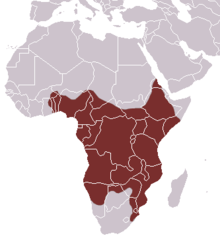Rusty-spotted genet
Appearance
| Rusty-spotted genet | |
|---|---|

| |
| Scientific classification | |
| Kingdom: | |
| Phylum: | |
| Class: | |
| Order: | |
| Family: | |
| Genus: | |
| Species: | G. maculata
|
| Binomial name | |
| Genetta maculata[2] (Gray, 1830)
| |

| |
| Rusty-spotted genet range | |
| Synonyms | |
| |
The rusty-spotted genet (Genetta maculata) is a genet, also called panther genet and large-spotted genet, is widely distributed in sub-Saharan Africa. It is considered common and therefore listed as Least Concern in the IUCN Red List.[1]
Characteristics
The rusty-spotted genet has short whitish grey to pale yellow coloured fur with dark spots and a continuous dark line across the back. The spots of the upper two dorsal rows are round or square, brown in the center and darker outside. In head-to-body length it ranges from 42 to 52 cm (17 to 20 in). Its 40 to 53 cm (16 to 21 in) long tail is ringed and has a dark tip. Its feet are of the same colour as the fur. It weighs from 1.3 to 3 kg (2.9 to 6.6 lb).[3][4]
References
- ^ a b Template:IUCN
- ^ Wozencraft, W. C. (2005). "Genetta maculata". In Wilson, D. E.; Reeder, D. M. (eds.). Mammal Species of the World: A Taxonomic and Geographic Reference (3rd ed.). Johns Hopkins University Press. p. 556. ISBN 978-0-8018-8221-0. OCLC 62265494.
- ^ Gaubert, P., Taylor, P. J., & Veron, G. (2005). Integrative taxonomy and phylogenetic systematics of the genets (Carnivora, Viverridae, Genetta): a new classification of the most speciose carnivoran genus in Africa. In: Huber, B. A., Sinclair, B. J., Lampe, K.-H. (eds.) African Biodiversity: Molecules, Organisms, Ecosystems. Proceedings of the 5th International Symposium of Tropical Biology, Museum König, Bonn. Springer. Pp. 371–383.
- ^ Foley, C., Foley, L., Lobora, A., De Luca, D., Msuha, M., Davenport, T. R., & Durant, S. M. (2014). A Field Guide to the Larger Mammals of Tanzania. Princeton University Press.

